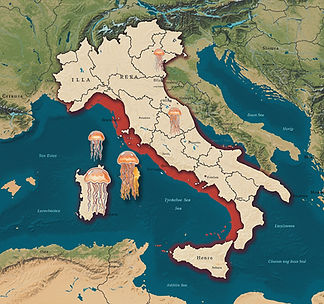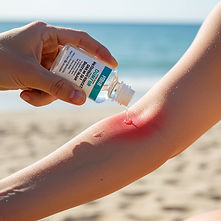A Guide to Jellyfish in Italy's Seas
Common Species, Sting Prevention, and Safety Tips for 2025
Jellyfish in Italy 2025 Key Facts
-
Jellyfish sightings in Italy are common, particularly from late summer into early autumn when water temperatures are highest.
-
The most prevalent species include the Mauve Stinger (Pelagia noctiluca) and the harmless Fried Egg Jellyfish (Cotylorhiza tuberculata).
-
Jellyfish blooms can occur in the Tyrrhenian Sea (near Rome and Naples) and the Adriatic Sea (near Venice and Rimini).
-
For first aid, rinse the affected area with seawater or vinegar, and avoid rubbing the sting.
-
The sting from most species causes a mild, localized burning sensation, but some can be more painful.

Common Jellyfish Species in Italy, Sting Prevention, and Updated Safety Tips for 2025
Italy's vast coastline, stretching along the Tyrrhenian, Adriatic, and Ionian seas, draws millions of visitors to its stunning beaches every summer. While the warm, crystal-clear waters are perfect for swimming, travelers should be aware of the marine life that inhabits them, including various species of jellyfish. Understanding which types of jellyfish are common, when they appear, and how to treat a sting is key to a safe and enjoyable Italian vacation.
As of August 2025, there are reports of jellyfish blooms across several key regions. The Mauve Stinger (Pelagia noctiluca) remains the primary concern, with a notable presence confirmed in parts of the Ligurian Sea and the Tyrrhenian Sea, particularly around the coasts of Tuscany, Naples, and Sicily.
In the Adriatic Sea, especially in the northern regions near Venice and Rimini, sightings of jellyfish are also being reported. Swimmers are advised to be vigilant and check for beach warning flags, which are often used to indicate the presence of marine life.
Jellyfish populations in Italian waters can fluctuate significantly. Blooms, or large swarms, are most likely to occur in the warmer months of late summer and early autumn. These blooms are a natural phenomenon influenced by sea currents, wind, and rising temperatures, which marine biologists are increasingly monitoring.
The Most Common Jellyfish in Italy
1. The Mauve Stinger (Pelagia noctiluca)
As one of the most widespread jellyfish in the Mediterranean, the Mauve Stinger is a frequent visitor to Italian shores. It is small, translucent, and covered in distinctive purple or pink spots. Its sting is painful, causing a sharp, burning sensation and leaving a red, inflamed rash that can last for several days.
-
Sting Severity: Painful; causes welts, blisters, and localized swelling.
-
Appearance: A small, bell-shaped body (up to 10 cm) with eight long tentacles and four oral arms. It can glow in the dark.
-
Season: Primarily late spring to autumn, often found in swarms close to the shore.
2. The Fried Egg Jellyfish (Cotylorhiza tuberculata)
Known for its unmistakable appearance, this species is named for its resemblance to a fried egg floating on the water. It is a large, harmless jellyfish with a flat, circular bell and a bright yellow center.
-
Sting Severity: Harmless to humans, with a very mild sting that is not noticeable.
-
Appearance: A bell up to 35 cm in diameter with a prominent yellow dome. Its eight oral arms have blue-violet appendages.
-
Season: Most abundant in calm, coastal waters during late summer.
3. The Barrel Jellyfish (Rhizostoma pulmo)
This large jellyfish is a common sight in the Adriatic and Tyrrhenian seas. Despite its imposing size, which can reach up to 60 cm, its sting is generally harmless to humans.
-
Sting Severity: Extremely mild, often described as a gentle stinging sensation.
-
Appearance: A massive, solid bell with a dense, cauliflower-like frilly mouth-arm structure. It has no tentacles.
-
Season: Most common in late spring and early summer.
High-Risk Seasons and Regions
Jellyfish blooms in Italy are most concentrated in the following areas and times:
-
Tyrrhenian Sea (West Coast): This area, including the Ligurian, Tuscan, and Campania coasts, can see an increase in jellyfish activity, especially in late summer.
-
Adriatic Sea (East Coast): The Adriatic is a known hotspot for jellyfish, with sightings being frequent around Venice and the Emilia-Romagna coast.
-
Ionian Sea (South Coast): Regions like Calabria and Puglia can experience blooms, especially if specific currents push jellyfish swarms northward from the rest of the Mediterranean.
Prevention and What to Do If You Get Stung
The best way to deal with jellyfish is to avoid them entirely.
Prevention Tips:
-
Check Local Warnings: Always look for warning signs or flags on beaches. Many organized beaches will have a flag system to alert swimmers to the presence of jellyfish.
-
Ask Locals: Lifeguards, hotel staff, and restaurant owners are excellent sources of information. Ask them about recent sightings before you enter the water.
-
Wear Protection: In areas known for jellyfish, consider wearing a rash guard, wetsuit, or a full-body swimsuit. This provides a simple but effective physical barrier.
-
Avoid Certain Times: Jellyfish often follow the sun and may be more visible in calm, shallow waters. Be especially cautious after a period of prolonged calm weather, as swarms can gather near the shore.
First Aid for a Sting:
If you are stung, stay calm and follow these steps:
-
Get Out of the Water: Exit the water immediately to prevent further stings.
-
Rinse the Area: Rinse the affected area with seawater. Do not use fresh water, as it can cause the remaining nematocysts to fire.
-
Apply a Neutralizer: If available, rinse the area with vinegar for at least 30 seconds. This is the most effective way to deactivate the stinging cells of most Mediterranean species, including the Mauve Stinger.
-
Remove Tentacles: Carefully and gently remove any remaining tentacles or stingers with tweezers. Do not use your bare hands.
-
Apply Heat: After rinsing and removing the tentacles, immerse the stung area in hot water (as hot as you can stand without burning) for 20-45 minutes. This helps to break down the venom and reduce pain. A hot pack or towel can also work.
-
Pain Relief: Over-the-counter pain relievers or antihistamines can help with pain and itching.
-
Seek Medical Help: If you experience severe symptoms like difficulty breathing, chest pain, swelling of the face or mouth, or if the pain is unbearable, seek immediate medical attention.

To learn more about Jellyfish in Mediterranean countries:

